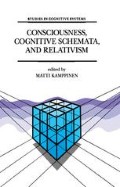Abstract
This part addresses methodological and philosophical questions involved in cultural anthropology, utilizing the recent developments in cognitive studies. Cognitivism, conceived as a general approach in cultural anthropology, aims at explaining behaviour by means of the processes of cognitive systems. Two explanatory strategies may be distinguished: intentional explanation of behaviour, and structural explanation by means of cognitive schemata. Of these two strategies, the structural explanation is of vital interest in cultural anthropology, and accordingly it is treated more extensively here. The notion of rationality will play a central role in both explanatory strategies. Intentional explanation assumes that the system’s dynamics are lawful and intelligible; structural explanation assumes that the schemata involved in steering the dynamics are built upon some simple rules.
Access this chapter
Tax calculation will be finalised at checkout
Purchases are for personal use only
Preview
Unable to display preview. Download preview PDF.
Bibliography
Agar, M.H. and Hobbs, J.R.: 1985, ‘How to Grow Schemata out of Interviews’, in Dougherty, J.W.D. (ed.), Directions in Cognitive Anthropology, Urbana: University of Illinois Press.
Bauer, R.M.: 1984, ‘Autonomic Recognition of Names and Faces in Prosopagnosia: A Neuropsychological Application of the Guilty Knowledge Test’, Neuropsychologia 22 (4), 457–469.
Casson, R.: 1983, ‘Schemata in Cognitive Anthropology’, Annual Review of Anthropology 12, 429–462.
Cummins, R.: 1983, The Nature of Psychological Explanation, Cambridge MA: MIT Press.
D’Andrade, R.: 1990, ‘Some Propositions About the Relations Between Culture and Human Cognition’, in Stigler, J.W., Shweder, R. and Herdt, G. (eds.), Cultural Psychology: Essays on Comparative Human Development, Cambridge: Cambridge University Press.
Dennett, D.C.: 1969, Content and Consciousness, London: Routledge and Kegan Paul.
Dennett, D.C.: 1978, Brainstorms, Brighton: Harvester.
Dennett, D.C.: 1987, The Intentional Stance, Cambridge MA: MIT Press.
Dougherty, J.W.D. (ed.): 1985, Directions in Cognitive Anthropology, Urbana: University of Illinois Press.
Gazzaniga, M.S., LeDoux, J.E. and Wilson, D.H.: 1977, ‘Language, Praxis, and the Right Hemisphere: Clues to Some Mechanisms of Consciousness’, Neurology 27, 1144–1147.
Gazzaniga, M.S. and LeDoux, J.E.: 1978, The Integrated Mind, New York: Plenum.
Gazzaniga, M.S.: 1988, `Brain Modularity: Towards a Philosophy of Conscious Experience’, in Marcel, A.J. and Bisiach, E. (eds.), Consciousness in Contemporary Science, New York: Oxford University Press.
Holland, D. and Quinn, N. (eds.): 1987, Cultural Models in Language and Thought, Cambridge: Cambridge University Press.
Holland, J.H., Holyoak, K.J., Nisbett, R.E. and Thagard, P.R.: 1986, Induction: Processes of Inference, Learning, and Discovery, Cambridge MA: MIT Press.
James, W.: 1950, The Principles of Psychology, Vols. 1 and 2 (First published in 1890.), New York: Dover Publications.
Johnson, M.: 1987, The Body in the Mind: The Bodily Basis of Meaning, Imagination, and Reason, Chicago: Chicago University Press.
Kamppinen, M.: 1989, Cognitive Systems and Cultural Models of Illness: A Study of Two Mestizo Peasant Villages of the Peruvian Amazon,Folklore
Fellows’ Communications 244. Helsinki: Academia Scientiarum Fennica. Kamppinen, M. and Raivola, P.: ms, Boundaries.
LeDoux, J., Wilson, D.H. and Gazzaniga, M.S.: 1977, ‘A Divided Mind: Observations on the Conscious Properties of the Separated Hemispheres’, Annals of Neurology 2, 417–421.
Lévi-Strauss, C.: 1963, Structural Anthropology, New York: Harper and Row.
Lévi-Strauss, C.: 1969, The Raw and the Cooked, New York: Harper and Row.
Marks, C.E.: 1981, Commissurotomy, Consciousness and Unity of Mind, Cambridge MA: MIT Press.
Minsky, M.: 1975, ‘A Framework for Representing Knowledge’, in Winston, P. (ed.), The Psychology of Computer Vision, New York: McGraw-Hill.
Minsky, M.: 1985, The Society of Mind, New York: Simon and Schuster.
Neisser, U.: 1976, Cognition and Reality: Principles and Implications of Cognitive Psychology, San Fransisco: Freeman.
Piaget, J.: 1970, Structuralism, New York: Harper and Row.
Rescher, N.: 1988, Rationality: A Philosophical Inquiry into the Nature and the Rationale of Reason, Oxford: Clarendon Press.
Rumelhart, D.E., McClelland, J.L. and the PDP research group: 1986, Parallel Distributed Processing, Vols. 1 and 2, Cambridge MA: MIT Press.
Schacter, D.L.: 1990, `Toward a Cognitive Neuropsychology of Awareness: Implicit Knowledge and Anosagnosia’, Journal of Clinical and Experimental Neuropsychology 12 (1), 155–178.
Schank, R. and Abelson, K.: 1977, Scripts Plans Goals and Understanding, London: Lawrence Erlbaum Associates.
Shweder, R.: 1991, Thinking Through Cultures: Expeditions in Cultural Psychology, Cambridge MA: Harvard University Press.
Smith, B. (ed.): 1982, Parts and Moments: Studies in Logic and Formal Ontology, Munich: Philosophia Verlag.
Smith, B.: 1991, ‘The Structures of the Common-Sense World’, in Pagnini, A. and Poggi, S. (eds.), Gestalt Theory: Its Origins, Foundations and Influence, Florence: Olschty.
Thorndyke, P.W.: 1984, ‘Applications of Schema Theory in Cognitive Research’, in Anderson, J. and Kosslyn, S. (eds.), Tutorials in Learning and Memory, San Fransisco: Freeman.
Werner, O. and Schoepfle, G.M.: 1987, Systematic Fieldwork, Vols. 1 and 2, Beverly Hills: Sage Publications.
Editor information
Editors and Affiliations
Rights and permissions
Copyright information
© 1993 Springer Science+Business Media Dordrecht
About this chapter
Cite this chapter
Kamppinen, M. (1993). Cognitive Schemata. In: Kamppinen, M. (eds) Consciousness, Cognitive Schemata, and Relativism. Studies in Cognitive Systems, vol 15. Springer, Dordrecht. https://doi.org/10.1007/978-94-017-1141-8_3
Download citation
DOI: https://doi.org/10.1007/978-94-017-1141-8_3
Publisher Name: Springer, Dordrecht
Print ISBN: 978-90-481-4269-9
Online ISBN: 978-94-017-1141-8
eBook Packages: Springer Book Archive

